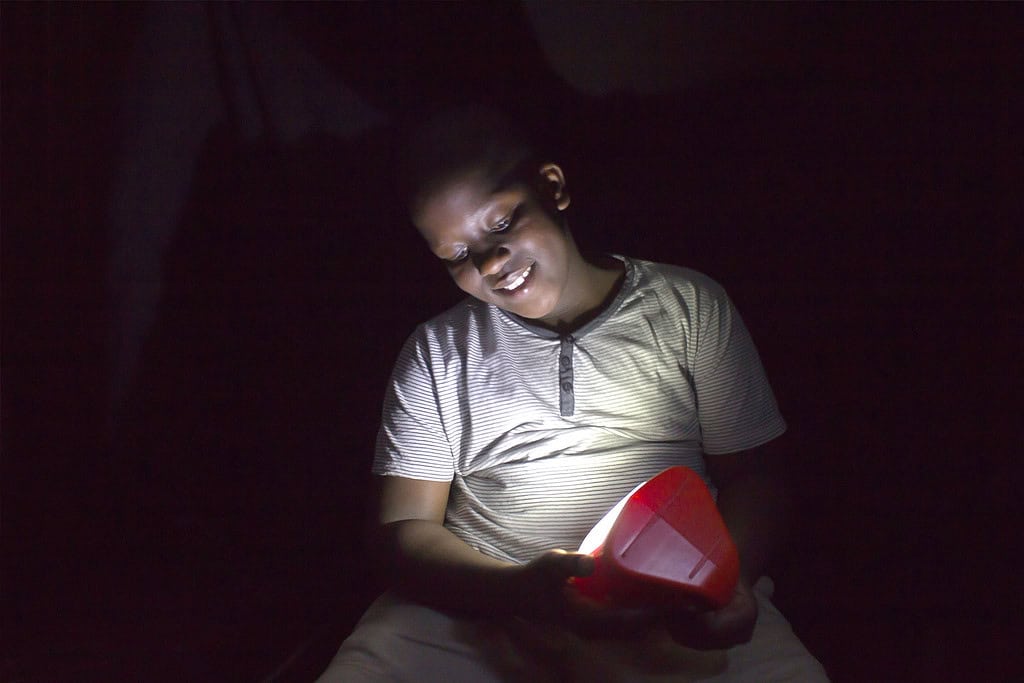Lighting the Way: A Look at Solar Energy’s Impact on Poverty Alleviation
- Blog
- Renewable energy

In the last decade, solar lanterns have emerged as a clean, cost-effective solution to provide access to modern energy to the 1.2 billion people currently living off-grid. These small, portable and rechargeable lights fulfill an immediate need for the poor and, as a result, have become increasingly widespread in countries across Africa, South Asia and beyond. They are affordable, easy to use and require little maintenance. And for families who’ve become accustomed to life stopping when the sun sets, a solar lantern can mean hours of light to enjoy dinner together, do homework for class tomorrow, or keep a business open a little later.
While it’s clear at a basic level that access to energy has the potential to transform a family’s standard of living — from cutting monthly costs to contributing to the improved health of a household — there is little academic evidence connecting solar lights to poverty alleviation. With solar energy quickly becoming a smart, cheap and cleaner alternative to fossil fuels, we want to understand its impact on the lives of the poor. With funding from Google, and in partnership with SolarAid and ETH Zurich, the Swiss Federal Institute of Technology, we set out three years ago to learn more about solar energy’s impact on the alleviation of income poverty.
The research worked with more than 1000 low-income households in rural Kenya to learn more how they valued small-scale solar products. In Africa, nearly 70 percent of households do not have access to electricity and, in rural Kenya alone, roughly 93 percent of the population lives without electricity. The study set out to understand how these households used solar products, how much they save and the impact they had in their day-to-day lives.
Here’s what we learned:
Solar lanterns save cash. As part of the research, low-income customers were offered a variety of solar lanterns at market price, subsidized prices, or free of charge, enabling families to replace kerosene lamps with a clean solar light. As a result, households reduced their monthly expenditure on energy by roughly half, freeing between one to two percent of total household expenditure.
Price matters. As anticipated, the demand for solar lanterns was heavily connected to the price offered. Close to 69 percent of households jumped at the opportunity to purchase a light at a discounted rate of $4 while only 29 percent made the purchase at the market price of $9. But 100 percent took the opportunity to use a solar light when offered free. Of course, it’s no surprise that demand rises with a lower price, but this is the first evidence of the extent of price-sensitivity of low income consumers.
Poorer households spend a larger share of their total expenditure on energy. The findings show that the poorest households spend a relatively large proportion of their income on energy (the poorest quintile spent around 10 percent of their total expenditure in energy). But as families become wealthier, energy expenditure falls as a proportion of total expenditure (the average across all households was around 5 percent of their total expenditure).
Everyone loves (and uses) a solar lantern. They’re easy to use and, whether households were given a lantern free of charge or paid for them, their usage and behavior didn’t change. This suggests that users derive value from the lights regardless of how they obtain them. It could mean that there is a role for subsidy in reaching the very poorest with lighting.
These lessons are helping prove that solar lanterns play a small but significant role in improving the economic welfare of the poor. By fulfilling an immediate need, solar lights are the fastest and least expensive way for low-income families to access modern energy and move up the energy ladder. They also provide valuable insight to companies, governments and nonprofits about the price sensitivity of different types of consumers, in order to support market development, vital in achieving the UN Sustainable Development Goal of universal energy access by 2030.
To read more about the results of the research download the summary report here and the full academic working paper here.
This is the first installment of a series of lessons from a range of new research into the social impact of off-grid energy in emerging markets. You can find the second installment here.
***
The research is complemented by Acumen’s own customer-based data collection applying our Lean Data approach. This work was originally conceived by Kat Harrison, formerly head of research and impact at SolarAid and now Acumen’s Associate Director of Impact.
